Abstract
Background
Methods
Results
References
Fig. 1
Prevalence of human papillomavirus (HPV) types in 18,815 Korean women.
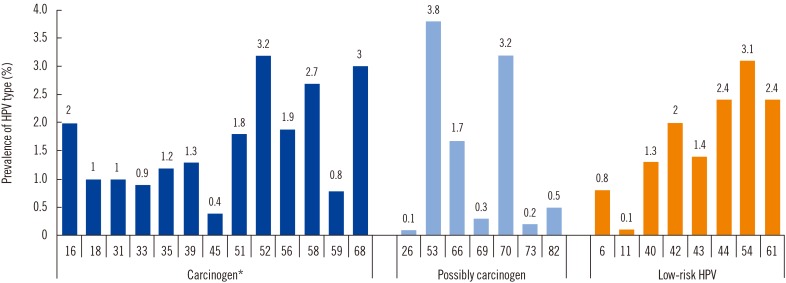
Fig. 2
Age-specific prevalence of human papillomavirus (HPV) infection for different cytology grades. P value for trend of HPV infection prevalence according to age group was determined by using Cochran-Armitage trend test.
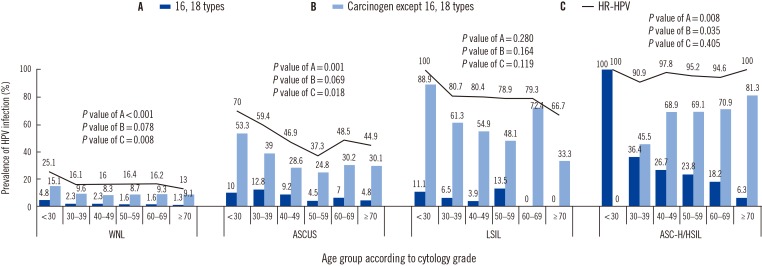
Table 1
Characteristics of the study population
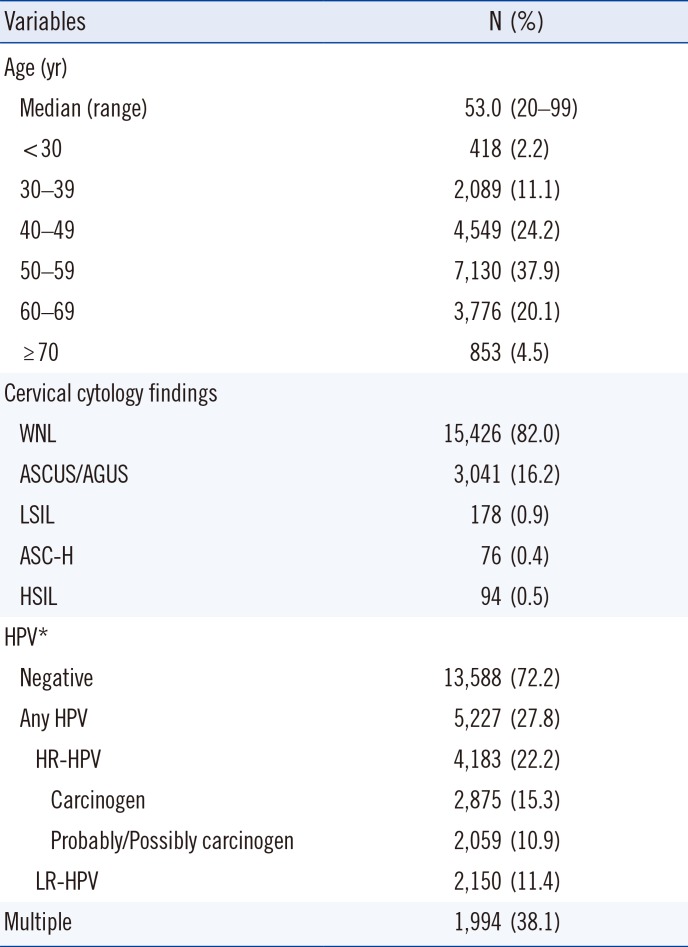
*Number of HPV infections includes single and multiple infections.
Abbreviations: WNL, well normal limit; ASCUS, atypical squamous cells of undetermined significance; AGUS, atypical glandular cells of undetermined significance; LSIL, low-grade squamous intraepithelial lesion; ASC-H, atypical squamous cells without excluding HSIL; HSIL, high-grade intraepithelial lesion; HPV, human papillomavirus; HR-HPV, high-risk human papillomavirus; LR-HPV, low-risk human papillomavirus.
Table 2
Distribution and prevalence of individual HPV genotypes according to age
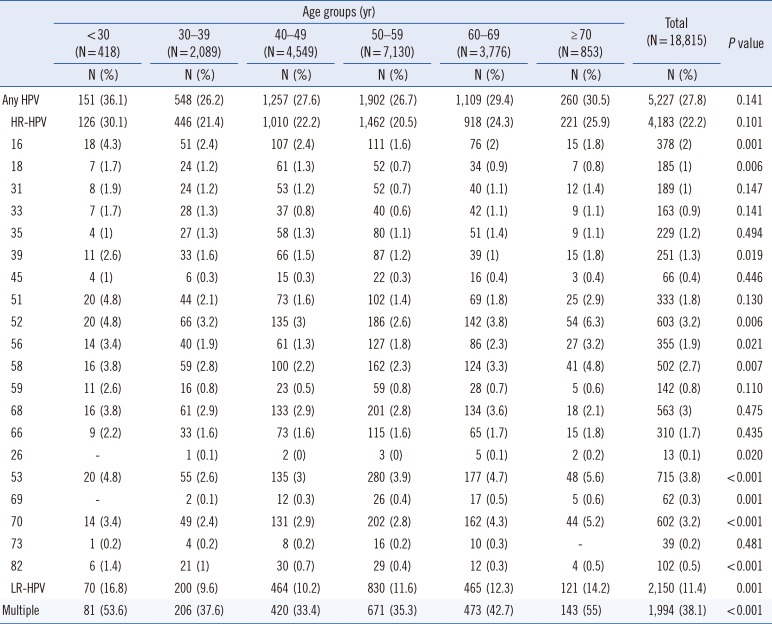
Table 3
Distribution and prevalence of individual HPV genotypes according to cervical cytology findings
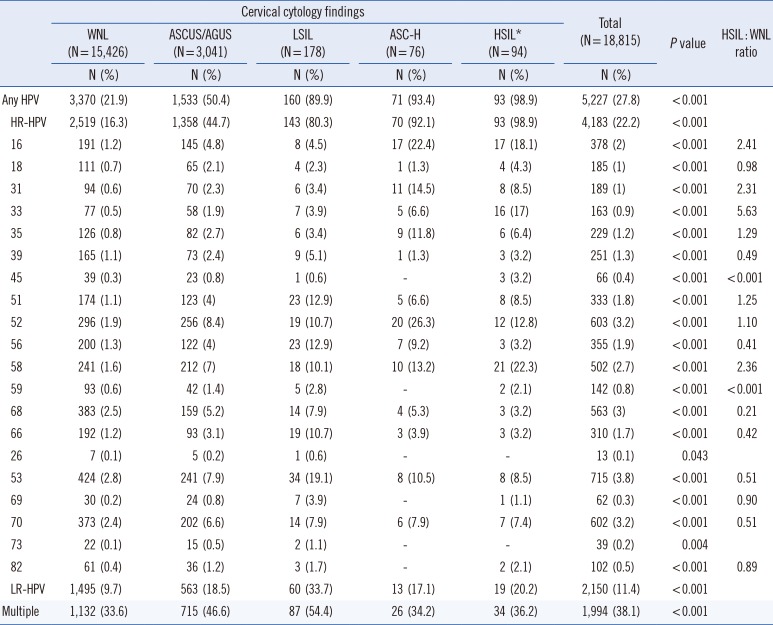
P value for trend of HPV infection prevalence rate according to cervical cytology findings was determined by using the Cochran-Armitage trend test.
*HSIL included two cancer cases (squamous cell carcinoma and adenocarcinoma).
Abbreviations: WNL, well normal limit; ASCUS, atypical squamous cells of undetermined significance; AGUS, atypical glandular cells of undetermined significance; LSIL, low-grade squamous intraepithelial lesion; ASC-H, atypical squamous cells without excluding HSIL; HSIL, high-grade intraepithelial lesion; HPV, human papillomavirus; HR-HPV, high-risk human papillomavirus; LR-HPV, low-risk human papillomavirus.
Table 4
HPV genotype prevalence compared with earlier reports
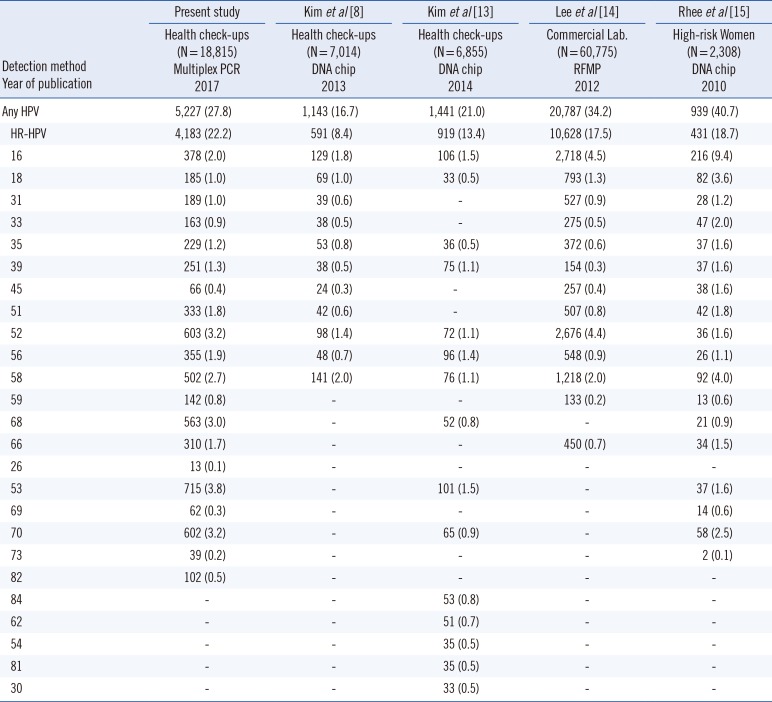
|
Detection method Year of publication |
Present study | Kim et al [8] | Kim et al [13] | Lee et al [14] | Rhee et al [15] |
|---|---|---|---|---|---|
|
Health check-ups (N=18,815) Multiplex PCR 2017 |
Health check-ups (N=7,014) DNA chip 2013 |
Health check-ups (N=6,855) DNA chip 2014 |
Commercial Lab. (N=60,775) RFMP 2012 |
High-risk Women (N=2,308) DNA chip 2010 |
|
| Any HPV | 5,227 (27.8) | 1,143 (16.7) | 1,441 (21.0) | 20,787 (34.2) | 939 (40.7) |
| HR-HPV | 4,183 (22.2) | 591 (8.4) | 919 (13.4) | 10,628 (17.5) | 431 (18.7) |
| 16 | 378 (2.0) | 129 (1.8) | 106 (1.5) | 2,718 (4.5) | 216 (9.4) |
| 18 | 185 (1.0) | 69 (1.0) | 33 (0.5) | 793 (1.3) | 82 (3.6) |
| 31 | 189 (1.0) | 39 (0.6) | - | 527 (0.9) | 28 (1.2) |
| 33 | 163 (0.9) | 38 (0.5) | - | 275 (0.5) | 47 (2.0) |
| 35 | 229 (1.2) | 53 (0.8) | 36 (0.5) | 372 (0.6) | 37 (1.6) |
| 39 | 251 (1.3) | 38 (0.5) | 75 (1.1) | 154 (0.3) | 37 (1.6) |
| 45 | 66 (0.4) | 24 (0.3) | - | 257 (0.4) | 38 (1.6) |
| 51 | 333 (1.8) | 42 (0.6) | - | 507 (0.8) | 42 (1.8) |
| 52 | 603 (3.2) | 98 (1.4) | 72 (1.1) | 2,676 (4.4) | 36 (1.6) |
| 56 | 355 (1.9) | 48 (0.7) | 96 (1.4) | 548 (0.9) | 26 (1.1) |
| 58 | 502 (2.7) | 141 (2.0) | 76 (1.1) | 1,218 (2.0) | 92 (4.0) |
| 59 | 142 (0.8) | - | - | 133 (0.2) | 13 (0.6) |
| 68 | 563 (3.0) | - | 52 (0.8) | - | 21 (0.9) |
| 66 | 310 (1.7) | - | - | 450 (0.7) | 34 (1.5) |
| 26 | 13 (0.1) | - | - | - | - |
| 53 | 715 (3.8) | - | 101 (1.5) | - | 37 (1.6) |
| 69 | 62 (0.3) | - | - | - | 14 (0.6) |
| 70 | 602 (3.2) | - | 65 (0.9) | - | 58 (2.5) |
| 73 | 39 (0.2) | - | - | - | 2 (0.1) |
| 82 | 102 (0.5) | - | - | - | - |
| 84 | - | - | 53 (0.8) | - | - |
| 62 | - | - | 51 (0.7) | - | - |
| 54 | - | - | 35 (0.5) | - | - |
| 81 | - | - | 35 (0.5) | - | - |
| 30 | - | - | 33 (0.5) | - | - |




 PDF
PDF ePub
ePub Citation
Citation Print
Print


 XML Download
XML Download